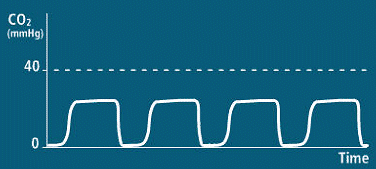 |
Alaris® EtCO2 module
Topic 6: Responding to Abnormal Waveforms
|
Abnormal Waveform: *Hyperventilation
Case: Next day Mr. Johnson experienced shortness
of breath. His RR  to 28 breaths/minute. Subsequently his EtCO2
to 28 breaths/minute. Subsequently his EtCO2  from
35 to 25 mmHg. Pneumonia, pulmonary embolism, and congestive heart
failure were all ruled out. from
35 to 25 mmHg. Pneumonia, pulmonary embolism, and congestive heart
failure were all ruled out.
|
|
Clinical Findings & Abnormal Waveform1-3:
 RR RR EtCO2 because
more frequent exhaled tidal volume EtCO2 because
more frequent exhaled tidal volume- Followed by less CO2 gas to exhale (blowing
off CO2)
Possible Causes1-3:
- Increase in pain level/splinting area of pain
- Increase in anxiety/fear
- Respiratory distress/shortness of breath
Possible Responses1-3: Follow hospital protocols, which may include:
- Assess ABC's (Airway, Breathing, Circulation)
- Treat cause for
 RR RR
- Decrease pain stimulus/ encourage calm
- Notify M.D. of possible uncontrolled pain
|

|
1Capnography in the Management of the Critically Ill Patient,
EducationPAK for Critical Care and Procedural Sedation - A Guide to Capnography.
CD-ROM - Needham, MA. Oridion Medical. 2003.
2AACN Procedure Manual for Critical Care 4th Ed. (2001).
Ed. Lynn-McHale, D.J. & Carlson, K.K.. American Association of Critical
Care Nurses.
3Thalan's Critical Care Nursing Diagnosis and Management 4th Ed. (2001).
Ed. Urden, L.D.; Stacy, K.M.; & Lough, M.E. C.V. Mosby
*The following are examples of common EtCO2 waveforms. The waveform trends are examples only and do not represent all potential abnormal waveforms. Analysis of these waveform trends may provide an early indication of the noted possible causes. The associated possible responses are suggestions only and are not meant to replace current clinical practice or hospital protocols. Always consult hospital protocols. Abnormal waveforms are not always associated with alarms.

